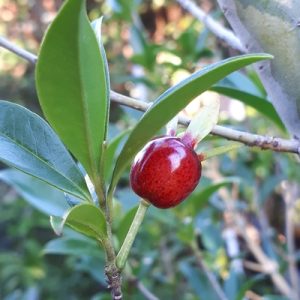Eugenia involucrata (aggregata)
Cherry of the Rio Grande, black cherry, cherry tree
Origin
Native to the neotropics – mainly the Atlantic forest regions of southern and south eastern Brazil.
Climate
It is adapted to open sub-tropical and tropical areas, from sea level to 1300m, where conditions are drier than experienced in more western Brazilian forests. Seedlings may succumb to cold weather, but when mature they are more tolerant than many other Eugenia species and are able to survive brief periods of mild frost.
Plant Description
A small slow growing multi-branched perennial evergreen bush, 4-6m high in our edapho-climatic conditions, with a shallow root system and a dense canopy. The opposite leathery entire elliptic obovate-oblong glossy leaves containing oil glands are 5-10 X 1-3cm. They have marginal veins, a short grooved petiole, and are dark green on the upper surface and a finely pubescent lighter colour underneath. There is considerable morphological variation in these features depending on climate and geography. The species is diploid with 2n = 22 chromosomes.
Relatives
Cherry of the Rio Grande is in the large Myrtaceae family that includes 144 genera and about 5500 species classified into 10 clades. There are approx. 1100 species in the genus Eugenia, 300 of which are endemic to Brazil. The homogeneous morphology of different plant parts makes taxonomy difficult, but this is now being significantly improved through genetic studies. Pitomba (E luschnathiana) is the closest fruiting relative, but there are many others in the family including grumichama, rose apple, pitanga, feijoa, jaboticaba and cherry guava.
Soils
It will grow in most soil types as long as they are well-drained. Slightly acid pH is preferred and in alkaline soils micronutrient deficiencies may become apparent on the foliage; these problems can be addressed with sprays in the short term, but soil pH should be brought into range.
Propagation
Usually by seeds which are recalcitrant. They should be obtained from fruit at the light red skin stage, surrounding pulp removed, washed and then planted without any drying phase in a soil-free medium with a few pellets of controlled release fertiliser. There is no dormancy period that has to be satisfied, and germination at 25°C may take 4-5 weeks with 90% success rate. Grafting with scions from trees that produce good yields of tasty fruit is used only rarely.
Cultivars
Cherry of the Rio Grande is one of those native sth American fruits eaten by locals and hardly known outside endemic areas. There are no commercial orchards, and there has been no proper breeding research. Dulcissima and Giant are two selected varieties, but sourcing them in WA would be difficult.
Flowering and Pollination
Terminal or axillary inflorescences are indeterminate with 1-5 tetramerous bisexual white-petalled flowers, 2-3cm wide on 1-3cm pedicels, with prominent subtending bracts, >100 free stamens, and an epigynous ovary containing 50-60 ovules; stigmas are of the dry type, and nectaries are absent. Flowers bloom in late winter and throughout spring, each lasting for only one day. Bees are the main pollinators, visually attracted by petals and stamens assisted by osmophore aromas, and they visit flowers in the early morning and late afternoon with pollen being the floral reward. The species is autogamous and polyembryony occurs in some seeds; molecular studies have shown a high degree (>80%) of genetic similarity between plants even though organs may be polymorphic depending on prevailing environmental factors.
Cultivation
Generally a low maintenance tree that’s easy to grow. Although they prefer a sunny position, part shade is tolerated. Adequate nutrition and water should be supplied at all times, particularly during flowering and fruit development, generally increasing fertiliser rate commensurate with tree size; little research has been conducted to provide detailed regimes. Although they have a shallow root system, they have some tolerance to dry conditions but at the cost of reduced yield. Mulching is always beneficial.
Wind Tolerance
As a small multi-stemmed bush, wind resistance is good.
Pruning
Containing tree height is not really a problem and pruning is minimal. Plants can be trained as a hedge without overly affecting fruiting behaviour.
The Fruit
Fruit shape can be globose, ellipsoid or pyriform, 2-4cm long, with dark red-violet thin skin and conspicuous remnant calyces. They usually mature quickly, 4-6 weeks after flowering. Pulp is pleasantly juicy sweet with a sub-acid tanginess, comparable to the best of the other Eugenias. Most contain 2 rounded white seeds that are not eaten.
Fruit Production and Harvesting
Seedlings may take 3-5 years to begin producing fruit. Yield is not high but is usually better in warmer climates. Fruit should be picked when fully coloured.
Fruit Uses
It is usually consumed fresh or in the form of sweets, jellies, liqueurs, or dried. Fresh storage is possible for only a few days.
Pests and Diseases
Fruit may be attacked by Medfly. Rust and birds could also be problematic.
Comments
This species is endemic in Brazilian latitudes comparable to the sth west of WA, so can be grown here provided attention is given to our relatively poor soils. It could be grown in a pot for several years, and apart from producing fruit it has value as an attractive ornamental, especially when in bloom or fruiting.
